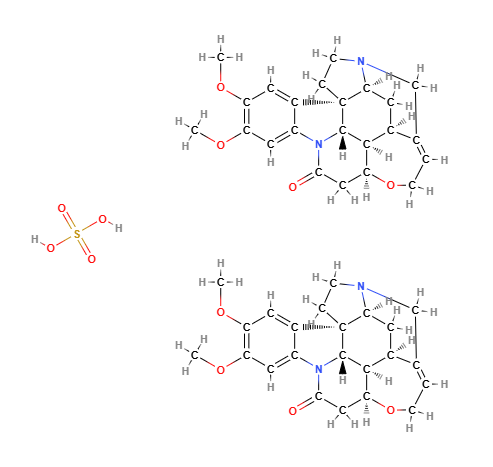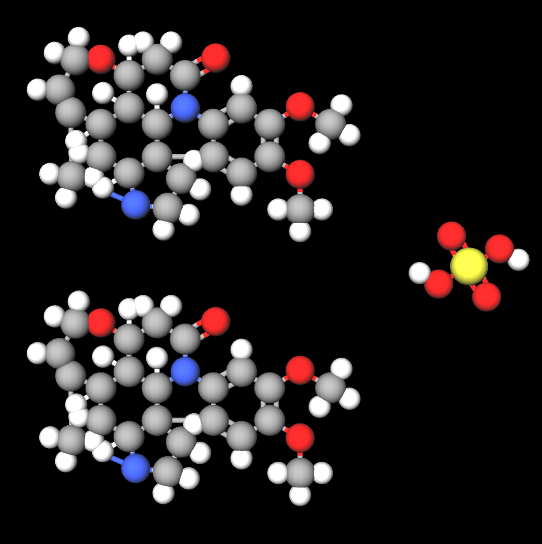Check the ingredients!
... live healthy!


| "Descrizione" by admin (19362 pt) | 2024-Sep-21 11:43 |
Brucine sulfate is a salt formed from brucine and sulfuric acid. It is derived from the seeds of the Strychnos nux-vomica tree and is known for its bitter taste. In herbal medicine, brucine sulfate has been used for its potential stimulant and digestive properties. In cosmetic formulations, it may offer astringent effects, making it useful for toning and tightening the skin.
Chemical Composition and Structure
The chemical composition of brucine sulfate includes:
Structurally, brucine sulfate consists of the brucine alkaloid bonded to the sulfate ion, which can affect its solubility and bioavailability compared to brucine alone.
Physical Properties
Appearance: Typically a white to pale yellow crystalline powder.
Solubility: Soluble in water and alcohol; the sulfate form increases its solubility compared to brucine.
pH: Slightly acidic in solution.
Odor: Odorless, making it suitable for various formulations.
Stability: Stable under normal storage conditions; however, it should be kept away from light and moisture.
Production Process
Extraction: Brucine sulfate is derived from the seeds of Strychnos nux-vomica, with brucine extracted through maceration or solvent extraction.
Sulfation: The extracted brucine is then treated with sulfuric acid to form brucine sulfate through a neutralization reaction.
Purification: The resulting brucine sulfate is purified to remove impurities and ensure high quality.
Formulation: Purified brucine sulfate is incorporated into various herbal and cosmetic products.
Applications
Medical: Used in traditional medicine for its stimulant properties, particularly for digestive health, tonic, bacteriostatic (1).
Cosmetics: Included in skincare products for its astringent effects, helping to tighten and tone the skin. It may also enhance the absorption of other active ingredients.
Food: Not typically used in food products due to its potential toxicity in high doses.
Industrial Uses: Occasionally used in pest control formulations as a natural insecticide.
Environmental and Safety Considerations
The Panel acknowledged that the available data were insufficient to support the safety of Quassin, Brucin and Brucin sulfate, Alcohol denatured with these denaturants, or SD Alcohol 39 and SD Alcohol 40, and for the Panel to reach a conclusion for these denaturants, more data are needed. (2).
Brucin can be toxic in certain doses, leading to potential side effects such as nausea or neurological symptoms. It can also cause skin irritation in sensitive individuals. Responsible sourcing and formulation practices are crucial to ensure that the ingredient is produced sustainably and free of harmful contaminants. Users should be informed about its potency and potential side effects, including in cosmetic applications.
 |  |
Molecular Formula C46H54N4O12S
Molecular Weight 887.0 g/mol
CAS 4845-99-2
UNII KY7O12XPOQ
EC Number 225-432-9
DTXSID5052123
References__________________________________________________________________________
(1) Li J, Hu S, Feng P, Xia Y, Pei Z, Tian J, Jiang K, Liu L, Cai X, Wu P. Brucine Sulfate, a Novel Bacteriostatic Agent in 3D Printed Bone Scaffold Systems. Polymers (Basel). 2024 May 17;16(10):1428. doi: 10.3390/polym16101428. PMID: 38794621; PMCID: PMC11124991.
Abstract. Bacterial infection is a common complication in bone defect surgery, in which infection by clinically resistant bacteria has been a challenge for the medical community. Given this emerging problem, the discovery of novel natural-type inhibitors of drug-resistant bacteria has become imperative. Brucine, present in the traditional Chinese herb Strychnine semen, is reported to exert analgesic and anti-inflammatory effects. Brucine's clinical application was limited because of its water solubility. We extracted high-purity BS by employing reflux extraction and crystallization, greatly improved its solubility, and evaluated its antimicrobial activity against E. coli and S. aureus. Importantly, we found that BS inhibited the drug-resistant strains significantly better than standard strains and achieved sterilization by disrupting the bacterial cell wall. Considering the safety concerns associated with the narrow therapeutic window of BS, a 3D BS-PLLA/PGA bone scaffold system was constructed with SLS technology and tested for its performance, bacteriostatic behaviors, and biocompatibility. The results have shown that the drug-loaded bone scaffolds had not only long-term, slow-controlled release with good cytocompatibility but also demonstrated significant antimicrobial activity in antimicrobial testing. The above results indicated that BS may be a potential drug candidate for the treatment of antibiotic-resistant bacterial infections and that scaffolds with enhanced antibacterial activity and mechanical properties may have potential applications in bone tissue engineering.
(2) Cosmetic Ingredient Review Expert Panel. Final report of the safety assessment of Alcohol Denat., including SD Alcohol 3-A, SD Alcohol 30, SD Alcohol 39, SD Alcohol 39-B, SD Alcohol 39-C, SD Alcohol 40, SD Alcohol 40-B, and SD Alcohol 40-C, and the denaturants, Quassin, Brucine Sulfate/Brucine, and Denatonium Benzoate. Int J Toxicol. 2008;27 Suppl 1:1-43. doi: 10.1080/10915810802032388.
Abstract. Alcohol Denat. is the generic term used by the cosmetics industry to describe denatured alcohol. Alcohol Denat. and various specially denatured (SD) alcohols are used as cosmetic ingredients in a wide variety of products. Many denaturants have been previously considered, on an individual basis, as cosmetic ingredients by the Cosmetic Ingredient Review (CIR) Expert Panel, whereas others, including Brucine and Brucine Sulfate, Denatonium Benzoate, and Quassin, have not previously been evaluated. Quassin is a bitter alkaloid obtained from the wood of Quassia amara. Quassin has been used as an insect antifeedant and insecticide and several studies demonstrate its effectiveness. At oral doses up to 1000 mg/kg using rats, Quassin was not toxic in acute and short-term tests, but some reversible piloerection, decrease in motor activity, and a partial loss of righting reflex were found in mice at 500 mg/kg. At 1000 mg/kg given intraperitoneally (i.p.), all mice died within 24 h of receiving treatment. In a cytotoxicity test with brine shrimp, 1 mg/ml of Quassin did not possess any cytotoxic or antiplasmodial activity. Quassin administered to rat Leydig cells in vitro at concentrations of 5-25 ng/ml inhibited both the basal and luteinizing hormone (LH)-stimulated testosterone secretion in a dose-related fashion. Quassin at doses up to 2.0 g/kg in drinking water using rats produced no significant effect on the body weights, but the mean weights of the testes, seminal vesicles, and epididymides were significantly reduced, and the weights of the anterior pituitary glands were significantly increased. The sperm counts and levels of LH, follicle-stimulating hormone (FSH), and testosterone were significantly lower in groups treated with Quassin. Brucine is a derivative of 2-hydroxystrychnine. Swiss-Webster mice given Brucine base, 30 ml/kg, had an acute oral LD(50) of 150 mg/kg, with central nervous system depression followed by convulsions and seizures in some cases. In those animals that died, respiratory arrest was the cause. The acute i.p. LD(50) for 15 ml/kg of Brucine base was 62.0 mg/kg, with central nervous system depression prior to the onset of convulsions, just as with oral Brucine. The acute intravenous (i.v.) LD(50) was 12.0 mg/kg. Brucine was nonmutagenic in an Ames assay at levels up to 6666 mu g/plate, with and without metabolic activation. In a repeat-insult patch test, for a hair care product containing 47% SD Alcohol 40 (95%), it was reported that Brucine Sulfate may be considered a nonprimary irritant and a nonprimary sensitizer. Three different sunscreen products (35% SD Alcohol 40-B, 72.4% SD Alcohol 40, and 74.5% SD Alcohol 40) did not show any signs of photoallergy in human subjects. Also, these three formulas did not exhibit any evidence of phototoxicity in humans. Denatonium Benzoate is a bitter substance detectable at a concentration of 10 ppb, discernibly bitter at 50 ppb, and unpleasantly bitter at 10 ppm. The distribution of topically applied lidocaine, a topical anesthetic chemically related to Denatonium Benzoate demonstrated that virtually no lidocaine appears in the plasma, suggesting that the larger Denatonium Benzoate molecule also would have little or no systemic exposure. Denatonium Benzoate (0.1%) did not show adverse effects in 10 rats in an acute inhalation toxicity test and 0.005% to 0.05% was nonirritating to ocular mucosa in 6 albino rabbits. The acute oral LD(50) for the male rats was 640 mg/kg and for females, 584 mg/kg. The LD(50) for the male rabbits was 508 mg/kg and for the female rabbits, 640 mg/kg. In two chronic toxicity studies, Denatonium Benzoate was administered (by gavage) at 1.6, 8, and 16 mg/kg/day, one using cynomologus monkeys and the other rats, resulted in no compound-related toxicity. The toxicity of SD Alcohols has also been tested, with implications for the particular denaturant used. An irritation test of 55.65% SD Alcohol 40-B denatured with Denatonium Benzoate using rabbits produced minimal effects. A spray formula containing 12% SD Alcohol 40-B was found to be nonirritating when evaluated for vaginal mucosal irritation in New Zealand white rabbits. Cosmetic formulations containing SD Alcohol 40-B (denatured with Denatonium Benzoate) were not sensitizers in repeated insult patch tests. A gel formula containing 29% SD Alcohol 40-B and a spray liquid containing 12% SD Alcohol 40-B did not induce photoallergy, dermal sensitization, or phototoxic response in human subjects. Although the absorption of ethanol (aka Alcohol for purposes of cosmetic ingredient labeling) occurs through skin, ethanol does not appear to affect the integrity of the skin barrier nor reach a very high systemic concentration following dermal exposure. Ethanol may be found in the bloodstream as a result of inhalation exposure and ingestion. Topically applied, ethanol can act as a penetration enhancer. Most of the systemic toxicity of ethanol appears to be associated with chronic abuse of alcohol. Although ethanol is denatured to make it unfit for consumption, there have been reports of intentional and unintentional consumption of products containing denatured alcohol. Ethanol is a reproductive and developmental toxicant. Ethanol is genotoxic in some test systems and it has been proposed that the genotoxic effects of ethanol are mediated via its metabolite, acetaldehyde. A brief summary is provided of the effects of chronic ingestion of alcohol including intoxication, liver damage, brain damage, and possible carcinogenicity. The CIR Expert Panel recognizes that certain ingredients in this group are reportedly used in a given product category, but the concentration of use is not available. Because dermal application or inhalation of cosmetic products containing these ingredients will not produce significant systemic exposure to ethanol, the CIR Expert Panel concluded that safety of the ingredients should be predicated on the safety of the denaturants used. The Panel considered that the adverse effects known to be associated with Alcohol ingestion included in this safety assessment do not suggest a concern for Alcohol Denat. or SD Alcohols because of the presence of the denaturants, which are added for the express purpose of making the Alcohol unpotable. The CIR Expert Panel has previously conducted safety assessments of t-Butyl Alcohol, Diethyl Phthalate, Methyl Alcohol, Salicylic Acid, Sodium Salicylate, and Methyl Salicylate, in which each was affirmed safe or safe with qualifications. Given their use as denaturants are at low concentrations of use in Alcohol, the CIR Expert Panel determined that Alcohol Denat. denatured with t-Butyl Alcohol, Diethyl Phthalate, Methyl Alcohol, Salicylic Acid, Sodium Salicylate, and Methyl Salicylate is safe as used in cosmetic formulations with no qualifications. Likewise, because they are denatured with either t-Butyl Alcohol, Diethyl Phthalate, or Methyl Alcohol, SD Alcohols 3-A, 30, 39-B, 39-C, and 40-C all are considered safe as used. The Panel considered the available data for Denatonium Benzoate and SD Alcohol 40-B to be sufficient to support the safety of these ingredients in cosmetics. Denatonium Benzoate is sufficiently bitter that it is an effective denaturant at only 0.0006%. The Panel recognized that data on dermal penetration of Denatonium Benzoate were not available, but considered that the available data on lidocaine, a smaller structurally related chemical, indicates that dermal exposure does not result in measurable systemic exposure. The available data, however, were not sufficient to support the safety of Quassin, Brucine, and Brucine Sulfate, Alcohol Denat. denatured with those denaturants, or SD Alcohol 39 and SD Alcohol 40 (SD Alcohols denatured with Quassin, Brucine, and/or Brucine Sulfate), and in order for the Expert Panel to reach a conclusion for these denaturants, additional data are needed
| Evaluate |